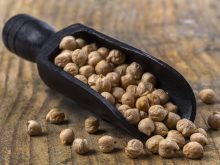From the September issue of Grainews
Over the last few years, the term vertical tillage has slowly crept into many farmers’ vocabulary. And while many have recently made a leap of faith and purchased one of these machines, others are still trying to understand just exactly what vertical tillage is all about. To give farmers a first-hand look at some of these implements and how they perform in the field, Tri-Star Farm Services (www.tristarfarms.com)organized a field day near Lipton, Sask., in late July. Three different brands of vertical and minimum tillage tools along with factory reps were on hand.
Read Also

Record large Canadian wheat and canola crops: Statistics Canada
Canadian wheat and canola production in 2025/26 (Aug/Jul) surpassed early expectations to hit new record highs, according to updated survey-based estimates from Statistics Canada released Dec. 4.
“Vertical tillage, now, is the big, cool thing,” says Todd Botterill of Botterill sales at Newton, Man. “But it’s actually been around since the ’50s. There was a researcher back then that started looking at what happens when you run a cultivator or disc. It creates a compaction or smear layer. That change of soil density actually redirects root growth.”
The tilled soil above the maximum depth of penetration of a regular tillage implement is soft, while the firmer smear layer just below it is harder and difficult for roots to penetrate. As a result, root growth often stops going down when it hits that compaction and starts following the path of least resistance, which is sideways. The result is a shallow-rooted crop stand, which is unable to access moisture stored deeper in the soil. That is the problem vertical tillage tools are designed to solve.
“[That researcher] also found that the smear layer also sealed the cracks in the ground, so you also lost the capillary moisture movement in the soil,” says Botterill. “What that means is where you have deeper moisture, it can’t migrate up to the seed.”
IMPACT ON YIELD
According to Botterill, about 10 years ago, the original research from the 1950s was re-examined by an agronomist in Illinois who found the existing vertical tillage implements from that time that did not create a smear layer. “What we found was over an eight-year farm test, the average [was] an eight bushel per acre corn yield increase where they ran vertical tillage tools over conventional tillage tools,” he says.
Those yield jumps increased to 25 bushels per acre during more difficult, dry growing seasons. “It’s when you have the crappy years, that’s when you see the big difference,” Botterill says. With a couple of consecutive difficult growing seasons here on the Prairies, it’s little wonder farmers are starting to take an interest in vertical tillage.
Modern high-speed, vertical tillage implements are designed to lift the soil and mix it with crop residue without creating a compaction layer. “It’s penetrating the ground, lifting the soil and breaking up the trash,” says Doug Achtymichuk, regional sales manager for Salford, a vertical tillage implement manufacturer. At the same time, the implement sends a shock wave downward that tends to fracture the soil at deeper depths. That gives these tools some ability to break up existing compaction or smear layers and aerate soils.
Some of the new high-speed implements on the market don’t fall strictly within the vertical tillage definition, though. But they also leave a firm field surface that is less susceptible to wind erosion while minimizing any deep compaction problems. These other tools are best described as minimum tillage; they are likely to be more aggressive, leaving fields a little blacker.
USING VERTICAL TILLAGE
The way to maximize the advantage of either of these implements types is to use a subsoiler first and fully eliminate any deep compaction layers. “The first step to vertical tillage is removing the horizontal tillage layers you already have in your soil,” Botterill says. “The freeze-thaw cycle is not going to remove those layers. You have to go in and remove them. That eliminates the change in soil density.” Using vertical tillage implements will then prevent those layers from reforming.
Using a hand-held penetrometer is the best way to identify where compaction layers are. Deep rippers should then only be set about one inch deeper than the bottom of the layer.
Making the switch to vertical or minimum tillage tools isn’t just for those who still use conventional tillage practices. Even no-till growers will see a benefit, says Botterill. “They’re not just a wet-weather emergency tool. They will help manage residue, they’ll help in the dry years maintain extra moisture and it will make sure you have healthy crops by allowing roots to grow deeper.”
With two wet years back-to-back in Saskatchewan, the need for an implement to deal with tough field conditions has significantly increased farmer interest in these tools. “This year we’ve had quite a few units retailed,” says Achtymichuk. “It’s been pretty popular in wet conditions. It helps speed up the (drying) process, allowing farmers to get into the field for seeding.”
Vertical tillage tools allow them to work in the worst of conditions,” says Botterill. “The wetter the better; the more residue the better. They allow you to deal with these problem times to get you through the hard years, and they also help you in the good ones.”
Vertical and minimum tillage implements typically need to be operated between eight and 10 miles per hour, and they have a relatively high horsepower demand. Farmers will need to provide eight to 10 horsepower per foot, says Achtymichuk.
Farmers attending the Tri-Star field demo came with a variety of uses in mind for these machines. “Some guys wanted to see light tillage, some wanted medium and some wanted to see heavy, so we got into sod,” says Kellen Huber, owner of Tri-Star Farm Services. Seeing vertical and minimum tillage implements break up pasture sod and leave a smooth, fallow surface after only a couple of passes surprised even him.
With the variety of models at the demo, some were capable of more aggressive tillage than others. And in many conditions, vertical and minimum tillage implements can be a replacement for most types of conventional tillage tools. “For the most part you don’t need the cultivators or the tandem discs (anymore),” Botterill says.
Farmers interested in buying a vertical or minimum tillage tool, really need to do their homework to ensure they pick the model that best meets their needs. “Do your research,” says Botterill. “Be sure you talk to people with the same crop and soil conditions that are looking for the same result.”
The Internet can be a useful place to start researching these implements. There are several chat rooms and YouTube videos showing them at work. Understanding how machines compare is essential to making the right buying decision. †
scott. [email protected]















